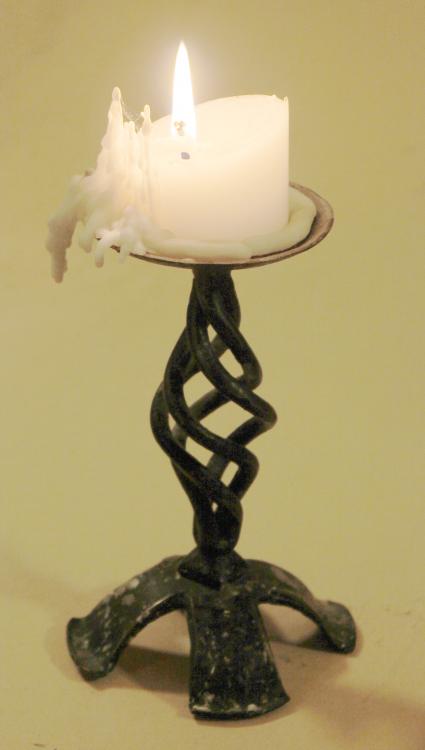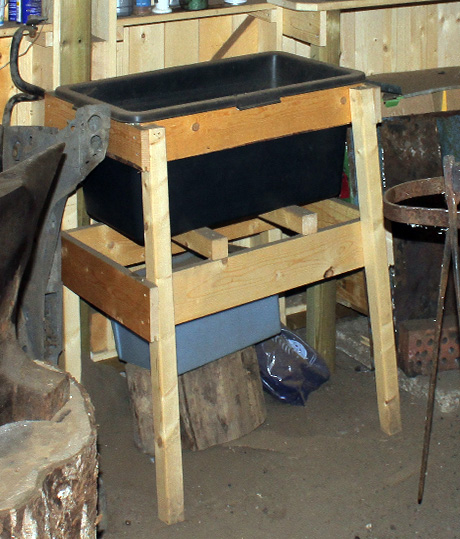
gote
-
Posts
779 -
Joined
-
Last visited
Content Type
Profiles
Forums
Articles
Gallery
Downloads
Events
Posts posted by gote
-
-
Mee too
-
Glenn, If I had one of these, I would never use it in the forge. Far too attractive to take any risks.
-
-
The angle grinder comment is only valid if you claim that you do it the 1875 way. We are all free blacksmiths and we have the right to do things in our own way. The comment tells me that the commenter is not a person with great insight in blacksmithing (or anything else for that matter)
Personally i use the hot cut if the piece is hot anyway, or the end will be heated or if I want the beveled ends and the stock is not too long to handle comfortably. If i want precision or if the cut is small (=quickly done) I use the hack saw. Otherwise I use the angle grinder.
I agree it is sometimes faster to use a punch than a drill press.
-
I use my small excavator. The smithy is built so the arm can reach in. Should I nickname it 'Apprentice'? It needs some training before it an use a sledgehammer.
-
I know a guy who makes his jigs of a steel plate with bent down edges that fits on the anvil with a square piece sticking down into the hardy hole. Then he bends a master and welds onto the plate. This allows him to make bends quickly with varying radius (spirals). I sometimes do the quick an dirty by bending an U and hold that in the vise.
-
A wood chisel is flat on one side because it allows it to make a straight cut. The straight side slides on the surface and the edge pares away any unevenness. The operation is not unlike a plane. The flat side is never ground. The bevel on the front is sharpened and it's true that it should be very slightly convex since this facilitates re-sharpening with a hand tool. This geometry is invaluable when shaping tenons and similar stuff. A wood chisel is used a lot by hand only without a mallet and the flatness is a must.
-
These are Japanese chisels. You can probably find a video showing how they are made. They usually are soft steel with a hard tip. However, Why do you want the groove? When I use a chisel for more exacting woodworking I am very glad my chisels have a perfectly flat side that allows me to cut with precision where a plane cannot get.
-
You do not need much power to form the rounded corners. (If the mesh is wowen not welded). You might be able to do it over your knee. They will come out pointed so you will have to trim them The mesh openings will become rhomboid. I make small boxes of mesh (to keep rodents out). I just make the straight bends a little at the time and adjust the corners as I go. Easy.
-
Improved mistakes - That is a good one Hope you do not mind if I add it to my vocabulary

-
I mostly make things I need but some are gifts.
-
For this very reason I made my workbench flush with the (coal) forge. I keep a piece of wood cut so that it supports at different heithgts depending upon how it is turned.
-
-
Why? because it allows me to keep one end cool so I can use my hand rather than tongs.
-
No anvil needs a nick name or any other name it is those who talk about it who need the name. "first correct the names" (Confucius)

-
Never heard about lost wax used for steel but it makes some sense. Interesting to note how the hardy hole is formed using a separate piece that fits into the mould.
-
I don't get it. How can you cast molten steel into a fiber glass and timber mold?? I would have thought that the steel would run straight through. Patterns for casting are positive pieces that are used to form the mould in a material that can stand the heat.
-
On 2015-11-26 at 9:51 PM, Frosty said:
Even an AIR oxy explosion has a rate of propagation in the range of 24,000fps. orbital velocity is around 25,000fps.
Frosty, you cannot mean that. You mean AIR Acetylene?? Otherwise you are quite right. Happy new year to you by the way
-
-
A merry Christmasn and a happy new year to all of you but especially to Glenn who makes this possible
-
Really nice. I will do a tree grille some time in the future - I hope.
-
If it is sold, the price was not too high.
-
This is really elegant. Great design. Somehow I feel that the eye wants to see what is joining the pieces. My eye that is. a subconscious fell that it may fall apart if I sneeze. I would go for brazing even at the cost of the finish. The design fits a between war's style so I think that the top could be made shiny with the copper line visible. I wish I could design such a beauty.
-
I bougt one of these together with som scrap iron. I had no idea of what to use it for. It will now get sharpened and a good handle.
Thank you for the tip.


That time of year: heat & condensation
in Building, Designing a Shop
Posted
I only have the problem with heavy pieces like the anvils and the lathe. The anvils have a coat of mixed lineseed oil and rust on the sides and I spray a thin coat of oil on the top when leaving. It does not stop condensation but it stops rust. The lathe is covered in an old blanket and has a small 200W thermostatically regulated heater underneath the bench. The blanket is needed anyway to stop dust from getting into the machinery. Today is -17C two days ago it was .22.